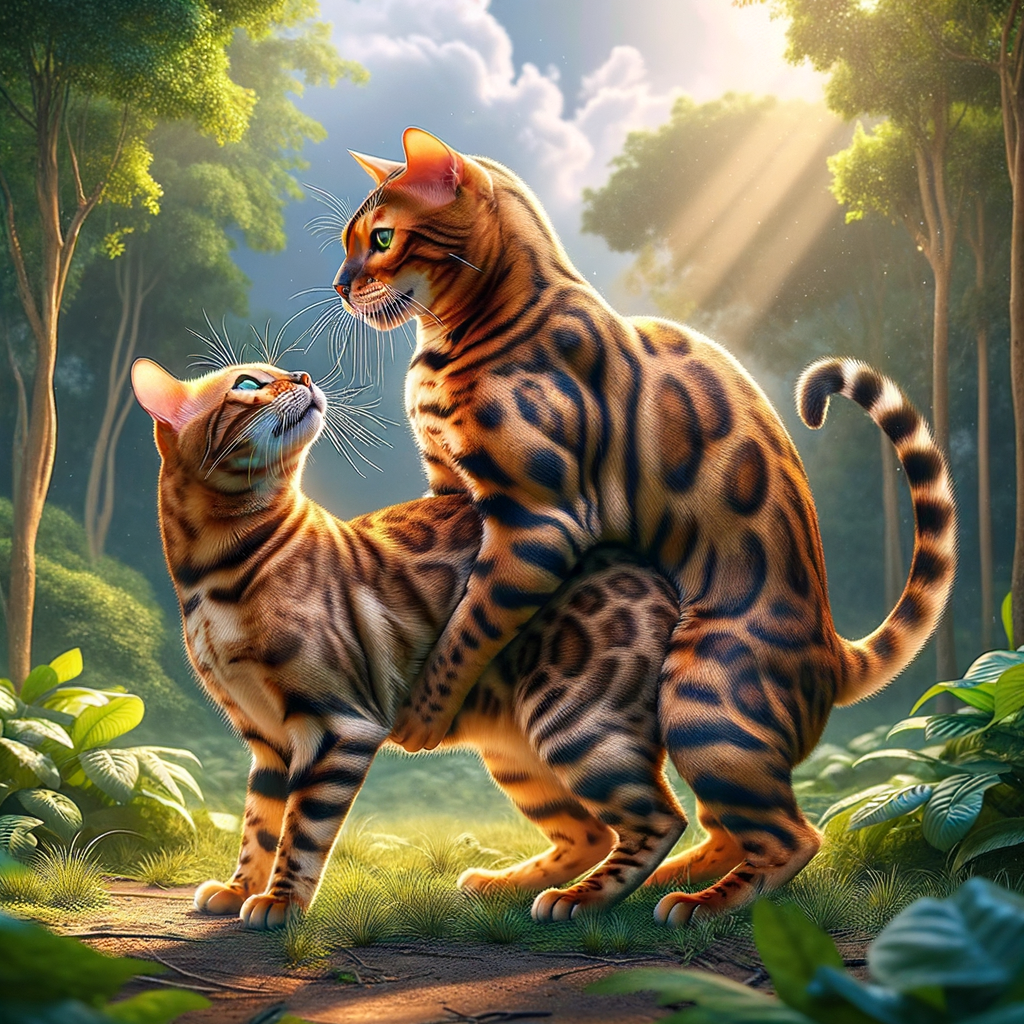
Introduction to Bengal Cat Breeding
- Overview of Bengal cat reproduction: Bengal cats are known for their unique spots and energetic nature. Female Bengal cats, called queens, can start breeding as early as six months old. Male Bengal cats, known as toms, reach sexual maturity around the same age. Breeding Bengal cats requires knowledge of their cycles and behaviors.
- Bengal cat mating habits: Knowing how Bengal cats mate helps in planning and ensuring healthy litters. Bengal cats have specific mating habits that differ from other breeds. For instance, they have a distinct courtship process that involves vocalizations and playful behavior.
Bengal Cat Courtship
Signs of Bengal Cat Courtship
- Behavioral changes: During courtship, Bengal cats often show noticeable changes in their behavior. They may become more vocal, purring and meowing more than usual. Additionally, they might start to rub against objects or people more frequently. These behaviors are ways for them to attract a mate.
- Physical signs: Physical signs are also evident during Bengal cat courtship. Female Bengal cats may display a raised tail and an arched back, indicating they are ready to mate. Males, on the other hand, might show increased grooming and a more muscular appearance.
Bengal Cat Mating Rituals
- Initial Courtship BehaviorsWhen Bengal cats start their courtship, they show specific behaviors. The male Bengal cat will often follow the female around. He might also make soft, chirping sounds to get her attention. The female, if interested, will respond by purring and rubbing against objects or the male cat.
- Progression of the Mating RitualAs the courtship progresses, the male Bengal cat will become more persistent. He may nuzzle and lick the female cat. The female will show her readiness by crouching down and raising her hindquarters. This position signals to the male that she is ready to mate. The mating itself is quick, usually lasting only a few seconds.
- Post-Mating BehaviorsAfter mating, both Bengal cats will groom themselves. The female may roll around on the ground, which is a common behavior seen in many cat species. The male might stay close to the female for a short time but will eventually lose interest and move away.
Bengal Cat Mating Season
When is the Bengal Cat Mating Season?
- Typical timing of the mating season: Bengal cats usually have their mating season in the spring and summer. During these warmer months, female Bengal cats, known as queens, are more likely to go into heat. This period is when they are most fertile and ready to mate.
- Factors affecting the mating season: Several factors can influence the timing and frequency of the Bengal cat mating season. These include:
- Climate: Warmer climates may extend the mating season, while colder climates can shorten it.
- Light exposure: Longer daylight hours in spring and summer can trigger the mating season.
- Health and nutrition: Healthy and well-nourished cats are more likely to have regular mating seasons.
- Age: Younger cats may have more frequent mating seasons compared to older cats.
Behavioral Changes During Bengal Cat Mating Season
- Increased ActivityDuring the mating season, Bengal cats become more active. They may run around more and seem restless. This is because they are looking for a mate. You might notice them climbing and exploring more than usual.
- Changes in VocalizationBengal cats often change the way they meow during mating season. They might meow louder and more frequently. This is a way to attract a mate. Sometimes, their meows can sound almost like a cry.
- Aggressive BehaviorSome Bengal cats can become more aggressive during mating season. They might hiss or growl at other cats. This is because they are competing for a mate. Keep an eye on them to prevent fights.
Bengal Cat Fertility
Bengal Cat Fertility
- Age of Sexual Maturity: Bengal cats typically reach sexual maturity between 6 to 9 months of age. This means they can start reproducing at a young age. However, it is often recommended to wait until they are at least one year old before breeding to ensure they are fully developed.
- Fertility Lifespan: The fertility lifespan of Bengal cats varies. Female Bengal cats can remain fertile for several years, usually up to 8 years. Male Bengal cats can stay fertile even longer, often into their senior years. Proper care and nutrition can help maintain their fertility for a longer period.
| Aspect | Details |
|---|---|
| Age of Sexual Maturity | 6 to 9 months |
| Fertility Lifespan | Females: Up to 8 years, Males: Longer |
Factors Affecting Bengal Cat Fertility
- NutritionCats need a balanced diet with the right amount of proteins, fats, and vitamins. A diet lacking in essential nutrients can lead to poor reproductive health. For example, a deficiency in taurine, an important amino acid, can cause infertility in cats.
- Health ConditionsVarious health conditions can affect a Bengal cat’s ability to reproduce. Common issues include infections, obesity, and hormonal imbalances. Regular vet check-ups can help detect and manage these problems early. For instance, untreated infections can lead to complications that may hinder fertility.
- Genetic FactorsGenetics play a significant role in Bengal cat fertility. Some cats may inherit traits that make them less fertile. Breeding practices should aim to select cats with strong reproductive health. This helps ensure that future generations are healthy and fertile.
Bengal Cat Breeding Cycle
Stages of the Bengal Cat Breeding Cycle
- Heat cycle: The heat cycle, also known as estrus, is when a female Bengal cat is ready to mate. This stage can last from 4 to 10 days. During this time, you may notice your cat becoming more affectionate, vocal, and restless.
- Mating: When a female Bengal cat is in heat, she is ready to mate. The mating process is usually quick, lasting only a few minutes. Ensure that both the male and female cats are healthy and free from diseases before allowing them to mate.
- Pregnancy: After successful mating, the female Bengal cat enters the pregnancy stage, which lasts about 63 to 67 days. During this period, provide proper nutrition and care to ensure the health of both the mother and the kittens.
- Post-pregnancy: After giving birth, the mother cat enters the post-pregnancy stage. This is a critical time for both the mother and the kittens. Ensure the mother has a quiet, comfortable place to nurse her kittens. Regular check-ups with a vet are essential to monitor the health of the mother and her kittens.
Managing the Bengal Cat Breeding Cycle
-
Monitoring Health During the Breeding Cycle
Vets can spot any health issues early. This helps in ensuring a smooth breeding process.
Here are some key health checks:
- Weight: Ensure your cat maintains a healthy weight.
- Diet: Provide a balanced diet rich in nutrients.
- Activity: Monitor activity levels to keep them fit.
-
Providing Appropriate Care at Each Stage
Each stage of the breeding cycle needs special care. Let’s break it down:
Stage Care Tips Heat Cycle Keep the environment calm and stress-free. Ensure she has enough food and water. Mating Introduce the male cat gradually. Supervise their interactions to ensure safety. Pregnancy Provide a comfortable nesting area. Increase food intake to support her growing kittens. Post-Pregnancy Monitor the mother and kittens closely. Ensure they are feeding well and staying warm.
Bengal Cat Pregnancy Signs
Early Signs of Bengal Cat Pregnancy
- Behavioral changes: Pregnant Bengal cats often show noticeable changes in behavior. They might become more affectionate, seeking extra attention and cuddles. Some cats may also become more vocal.
- Physical changes: Physical signs are also evident. You may notice your cat’s nipples becoming pinker and more prominent, a condition known as “pinking up.” Additionally, a slight weight gain and a rounder belly can be early indicators of pregnancy.
Confirming Bengal Cat Pregnancy
- Veterinary tests:The vet can perform several tests to check for pregnancy. One common test is an ultrasound. This test can show the kittens inside the mother cat’s belly. Another test is a blood test. This test checks for hormones that are only present when a cat is pregnant.
- Observing continued signs of pregnancy:Besides veterinary tests, you can also look for ongoing signs of pregnancy. These signs include a growing belly, increased appetite, and nesting behavior. Your Bengal cat may start to eat more and look for a quiet place to give birth.
Another sign is changes in behavior. Pregnant cats often become more affectionate or, sometimes, more reserved. They may also sleep more than usual.
Keep a close eye on your cat and note any changes. If you see these signs, it is likely that your Bengal cat is pregnant.
Ensuring Healthy Bengal Cat Breeding
- Bengal cat sexual behavior: Knowing how Bengal cats behave during mating helps in planning and ensuring successful breeding. For instance, female Bengal cats may exhibit specific signs when they are in heat, such as increased vocalization and restlessness. Recognizing these signs can help breeders time the mating process effectively.
- Role of responsible breeding in maintaining the Bengal cat breed: Responsible breeding practices are essential to avoid genetic issues and ensure the health of future generations. This includes selecting healthy breeding pairs, providing proper veterinary care, and avoiding inbreeding. Responsible breeders also contribute to the breed’s overall well-being by adhering to ethical standards and promoting awareness about Bengal cats.
| Key Points | Details |
|---|---|
| Sexual Behavior | Recognize signs of heat and mating behaviors. |
| Responsible Breeding | Select healthy pairs, avoid inbreeding, and provide veterinary care. |






